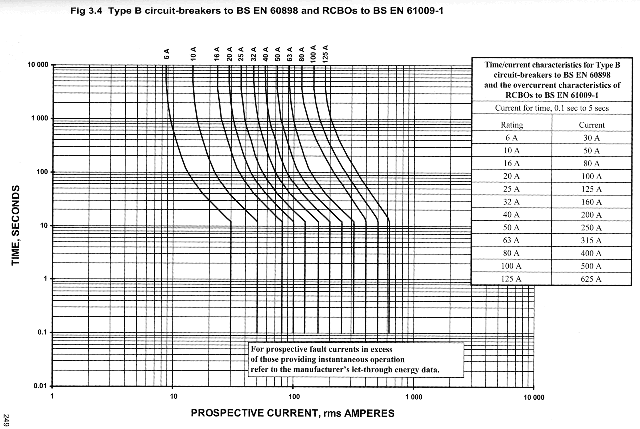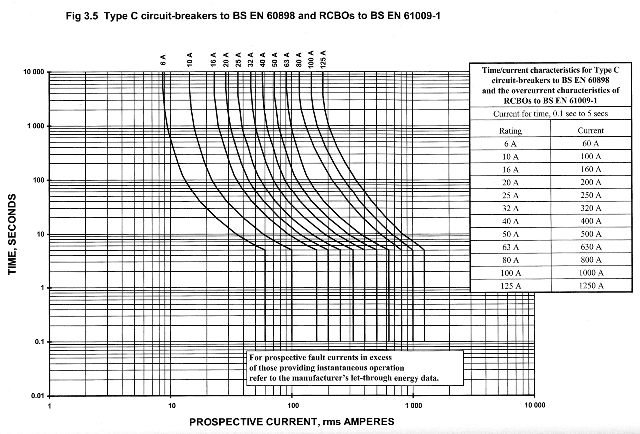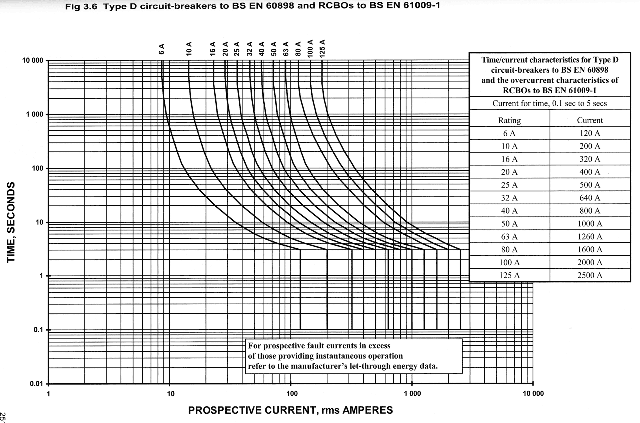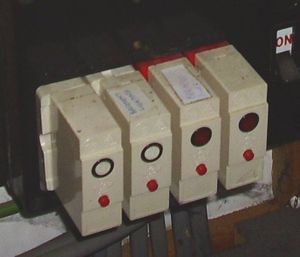Difference between revisions of "MCB"
(→Types B,C,D: trip times/current + 2 more minors) |
m (→Types B,C,D: typo) |
||
| (20 intermediate revisions by 3 users not shown) | |||
| Line 1: | Line 1: | ||
| − | '''MCB''' | + | '''MCB''' means 'miniature circuit breaker, aka breakers.' MCBs replace [[fuse]]s in most modern [[CU]]s. |
| − | + | ||
| + | [[Image:Mcbs.jpg|right|MCBs in a consumer unit]] | ||
==Ratings== | ==Ratings== | ||
| − | + | [[Lighting]] circuits | |
| − | * | + | * usually use 6A MCBs. |
| − | + | * Retrofit MCBs are generally 5A. | |
| + | * 10A lighting circuits are also sometimes used, primarily in larger buildings. | ||
| + | There was a restriction in the 16th edition regs (now removed in the 17th) that precludes the use of any light fittings that make use of miniature BC or SES lamp holders on circuits protected at 10A. | ||
| − | == | + | Socket circuits |
| − | An RCBO is a combination of MCB and [ | + | * [[House Wiring for Beginners#Ring|Ring circuits]] usually use 32A MCBs, |
| + | * retrofitted MCBs are generally 30A. | ||
| + | * Less common [[House Wiring for Beginners#Radial|radial]] socket circuits typically use a 16A or 20A MCB | ||
| + | |||
| + | Other loads | ||
| + | * Other values are used for other loads, and occasionally for socket & lighting circuits as well. | ||
| + | |||
| + | |||
| + | ==RCBO== | ||
| + | An RCBO is a combination of MCB and [http://wiki.diyfaq.org.uk/index.php?title=RCD#Types_of_RCD RCD] in one device. Use of these enables much greater [[RCD]] discrimination, and greatly reduces the chance of and consequences of RCD [[RCD|nuisance trips]] by cutting one circuit instead of several if an earth leakage fault occurs. RCBO cost is significantly higher than MCBs + RCD. | ||
| + | |||
| + | |||
| + | ==Trip currents== | ||
| + | Real life performance is rather more complex than simply tripping when rated current is exceeded. | ||
| + | |||
| + | Modern MCBs contain 2 trip mechanisms, one thermal, one magnetic. | ||
| + | * The thermal element is slow acting, and responds to sustained overload currents of at minimum 1.13-1.45 x rated current | ||
| + | * The magnetic element responds rapidly to substantial fault currents | ||
| + | * MCBs don't trip at a sustained low level overload currents, BS EN 60898 requires a MCB to carry upto 1.13 times its nominal current rating indefinitely | ||
| + | |||
| + | BS EN 60898 also requires a current of 1.45 (or more) times the nominal capacity to result in a trip. Currents between these thresholds may or may not cause a trip depending on external influences such as temperature etc. ''Note these are minimum performance requirements required for MCBs designed to meet the British Standard. Actual products can perform better than this.'' | ||
==Types B,C,D== | ==Types B,C,D== | ||
| − | |||
| − | |||
New MCBs come in 3 types: type B, type C & type D. | New MCBs come in 3 types: type B, type C & type D. | ||
| − | * Type B is used for the great majority of domestic MCBs, and has the quickest magnetic tripping of the 3 | + | * Type B is used for the great majority of domestic MCBs, and has the quickest magnetic tripping of the 3 |
* Type C is a little slower acting and a little less prone to some types of nuisance trip | * Type C is a little slower acting and a little less prone to some types of nuisance trip | ||
| − | * Type D is used where more tolerance of short term overcurrent is wanted, and is thus the least prone to nuisance trips. | + | * Type D is used where more tolerance of short term overcurrent is wanted, and is thus the least prone to nuisance trips. Use of type D MCBs requires careful calculation to ensure that adequate protection is provided for the circuit cables in the event of a fault. |
| + | |||
| + | The current needed to trip a MCB in 0.1 seconds is: | ||
| + | * Type B: between 3x and 5x rated current | ||
| + | * Type C: between 5x and 10x rated current | ||
| + | * Type D: between 10x and 20x rated current | ||
| − | The | + | The following trip response graphs give exact details (click for enlargement): |
| − | |||
| − | |||
| − | |||
| − | + | [[Image:Curve-MCBTypeB.png|640px]] | |
| − | Type A MCBs don't exist. | + | [[Image:Curve-MCBTypeC.png|640px]] |
| + | |||
| + | [[Image:Curve-MCBTypeD.png|640px]] | ||
| + | |||
| + | For new installs, circuits feeding fixed equipment (including lighting circuits) require a maximum 5 second disconnect time, and socket circuits a maximum 0.4 sec disconnect time. These times are straightforward to meet using type B MCBs. In some cases type Cs will also comply, but often not. | ||
| + | |||
| + | Some installations with mains [[Filament Lamps|filament lighting]] on type B MCBs are prone to nuisance trips. Whether use of type C or D MCBs can reduce nuisance tripping has been the subject of discussion on [[Newsgroups|uk.d-i-y]]. | ||
| + | |||
| + | Type A MCBs don't exist to save confusion with the current ratings in Amps). | ||
==Comparison with Fuses== | ==Comparison with Fuses== | ||
| − | [[Fuse|Rewirable fuses]], [[Fuse|cartridge fuses]] and MCBs all do the same job, and are all fully compliant with [[Regulations| | + | [[Fuse|Rewirable fuses]], [[Fuse|cartridge fuses]] and MCBs all do the same job, and are all fully compliant with [[Regulations|wiring regs]], and may be installed new. There are minor differences in performance between them. Its often assumed that MCBs are safer because they're newer, in reality there are various minor pros and cons on both sides. |
| − | * MCBs trip more quickly on medium | + | * MCBs trip more quickly on medium overcurrent |
| − | * [[Fuse]]s trip more quickly on heavy fault | + | * [[Fuse]]s trip more quickly on heavy fault currents |
| − | * MCBs are more likely to nuisance trip on [[Lamp Life| | + | * MCBs are more likely to nuisance trip on [[Lamp Life|filament lamp failures]]. This can cause [[safety]] problems as well as inconvenience, especially with [[Rewiring Tips#Stair Lighting|stair lighting]]. (Stair falls kill and injure orders of magnitude more people each year than electric shock) |
* Use of MCBs enables a slight increase in circuit current rating (from 5A to 6A, 30A to 32A) | * Use of MCBs enables a slight increase in circuit current rating (from 5A to 6A, 30A to 32A) | ||
| − | * MCBs are easily reset | + | * During circuit design, rewireable fuses impose a de-rating of the current carrying capacity of the cable used by 7/10ths of its nominal value, to allow for their slower response. See [[Calculating_A_Cable_Size|calculating cable size]] article for details. |
| − | + | * MCBs are easily reset, however MCBs may be abused because of this, by being repeatedly reset when a real [[fault]] occurs. | |
| − | * [[Fuse|Rewirable fuses]] can be abused by rewiring with the wrong [[Cables|wire]] | + | * [[Fuse|Rewirable fuses]] can be abused by rewiring with the wrong fuse [[Cables|wire]]. A card of fusewire and [[screwdriver]] kept near the CU much reduces the chance of this, but does not eliminate it. |
| − | + | * [[Fuse|Cartridge fuses]] are generally not as vulnerable to abuse (different ratings are physically not interchangeable due to size differences), but spares need to be stocked | |
| − | * [[Fuse|Cartridge fuses]] are not vulnerable to | + | * [[Fuse]]s have no mechanism of failure to act, so they can't fail to act (as long as they're not grossly mis-specified to begin with). |
| − | * [[Fuse]]s have no mechanism of failure to act, as long as they're | + | * MCBs are active mechanical devices, and do fail to act occasionally (creating a dangerous situation in some cases) |
| − | * MCBs are active mechanical devices, and do fail to act occasionally | ||
| − | |||
* High current [[fuse]]s (eg for showers) can get hot in use. | * High current [[fuse]]s (eg for showers) can get hot in use. | ||
| − | * | + | * Most domestic cartridge [[fuse]]s for [[Consumer Unit|CU]] use have a high breaking capacity (often in excess of 16kA), and hence may be preferable for installations with very low supply impedances. |
| − | * Some MCBs, particularly retrofits, are only rated to 3kA | + | * Rewireable BS3036 fuses often only have a 1 or 2kA breaking capacity (see marking on fuse S1A = 1kA, S2A = 2kA, S4A = 4kA). |
| − | * MCBs | + | * Some MCBs, particularly retrofits, are only rated to 3kA. |
| + | * MCBs often trip before the [[Fuse|mains plug fuse]] with a fault in an appliance, fuses seldom have this issue. | ||
| + | |||
| + | |||
| + | ==Breaking capacity (3kA, 6kA etc)== | ||
| + | [[image:Retrofit MCB 1360-3.jpg|thumb|Retrofit 1kA & 3kA MCBs]] | ||
| + | Any fuse or MCB also has a 'maximum breaking capacity' rating. This is the largest fault current it can reliably interrupt. If the fault current exceeds the device's breaking capacity, the MCB generally won't open the circuit, and will be destroyed. In these circumstances the incomer [[fuse]] breaks the supply. | ||
| + | |||
| + | In domestic situations its fairly rare for this to be a problem, however supplies (typically in towns or very close to a substation) with very low impedance, and very short final circuits with only a few meters of cable between CU and point of use, can potentially encounter a fault current exceeding the breaking capacity of some MCBs. | ||
| + | |||
| + | * Most domestic MCB can break 6kA | ||
| + | * Some ranges also do 10 or 16kA (often those designed for commercial installation and three phase CUs) | ||
| + | * Some plug in replacement MCBs only break up to 3kA. | ||
| + | * Old Wylex fusebox plugin MCBs are rated at 3kA for the switch type. The older push button MCBs (as pictured) are rated at 1kA for the 5A breakers and 3kA for the 15A-45A breakers. | ||
==See Also== | ==See Also== | ||
| − | * [[Fuse]] | + | *[[Fuse]] |
| − | * [[Special:Allpages|Wiki Contents]] | + | *[[RCD]] |
| − | * [[Special:Categories|Wiki Subject Categories]] | + | *[[CU]] |
| + | *[[:Category:Electrical|All electrical articles]] | ||
| + | *[[Special:Allpages|Wiki Contents]] | ||
| + | *[[Special:Categories|Wiki Subject Categories]] | ||
[[Category:Electrical]] | [[Category:Electrical]] | ||
Revision as of 13:22, 23 October 2014
MCB means 'miniature circuit breaker, aka breakers.' MCBs replace fuses in most modern CUs.
Ratings
Lighting circuits
- usually use 6A MCBs.
- Retrofit MCBs are generally 5A.
- 10A lighting circuits are also sometimes used, primarily in larger buildings.
There was a restriction in the 16th edition regs (now removed in the 17th) that precludes the use of any light fittings that make use of miniature BC or SES lamp holders on circuits protected at 10A.
Socket circuits
- Ring circuits usually use 32A MCBs,
- retrofitted MCBs are generally 30A.
- Less common radial socket circuits typically use a 16A or 20A MCB
Other loads
- Other values are used for other loads, and occasionally for socket & lighting circuits as well.
RCBO
An RCBO is a combination of MCB and RCD in one device. Use of these enables much greater RCD discrimination, and greatly reduces the chance of and consequences of RCD nuisance trips by cutting one circuit instead of several if an earth leakage fault occurs. RCBO cost is significantly higher than MCBs + RCD.
Trip currents
Real life performance is rather more complex than simply tripping when rated current is exceeded.
Modern MCBs contain 2 trip mechanisms, one thermal, one magnetic.
- The thermal element is slow acting, and responds to sustained overload currents of at minimum 1.13-1.45 x rated current
- The magnetic element responds rapidly to substantial fault currents
- MCBs don't trip at a sustained low level overload currents, BS EN 60898 requires a MCB to carry upto 1.13 times its nominal current rating indefinitely
BS EN 60898 also requires a current of 1.45 (or more) times the nominal capacity to result in a trip. Currents between these thresholds may or may not cause a trip depending on external influences such as temperature etc. Note these are minimum performance requirements required for MCBs designed to meet the British Standard. Actual products can perform better than this.
Types B,C,D
New MCBs come in 3 types: type B, type C & type D.
- Type B is used for the great majority of domestic MCBs, and has the quickest magnetic tripping of the 3
- Type C is a little slower acting and a little less prone to some types of nuisance trip
- Type D is used where more tolerance of short term overcurrent is wanted, and is thus the least prone to nuisance trips. Use of type D MCBs requires careful calculation to ensure that adequate protection is provided for the circuit cables in the event of a fault.
The current needed to trip a MCB in 0.1 seconds is:
- Type B: between 3x and 5x rated current
- Type C: between 5x and 10x rated current
- Type D: between 10x and 20x rated current
The following trip response graphs give exact details (click for enlargement):
For new installs, circuits feeding fixed equipment (including lighting circuits) require a maximum 5 second disconnect time, and socket circuits a maximum 0.4 sec disconnect time. These times are straightforward to meet using type B MCBs. In some cases type Cs will also comply, but often not.
Some installations with mains filament lighting on type B MCBs are prone to nuisance trips. Whether use of type C or D MCBs can reduce nuisance tripping has been the subject of discussion on uk.d-i-y.
Type A MCBs don't exist to save confusion with the current ratings in Amps).
Comparison with Fuses
Rewirable fuses, cartridge fuses and MCBs all do the same job, and are all fully compliant with wiring regs, and may be installed new. There are minor differences in performance between them. Its often assumed that MCBs are safer because they're newer, in reality there are various minor pros and cons on both sides.
- MCBs trip more quickly on medium overcurrent
- Fuses trip more quickly on heavy fault currents
- MCBs are more likely to nuisance trip on filament lamp failures. This can cause safety problems as well as inconvenience, especially with stair lighting. (Stair falls kill and injure orders of magnitude more people each year than electric shock)
- Use of MCBs enables a slight increase in circuit current rating (from 5A to 6A, 30A to 32A)
- During circuit design, rewireable fuses impose a de-rating of the current carrying capacity of the cable used by 7/10ths of its nominal value, to allow for their slower response. See calculating cable size article for details.
- MCBs are easily reset, however MCBs may be abused because of this, by being repeatedly reset when a real fault occurs.
- Rewirable fuses can be abused by rewiring with the wrong fuse wire. A card of fusewire and screwdriver kept near the CU much reduces the chance of this, but does not eliminate it.
- Cartridge fuses are generally not as vulnerable to abuse (different ratings are physically not interchangeable due to size differences), but spares need to be stocked
- Fuses have no mechanism of failure to act, so they can't fail to act (as long as they're not grossly mis-specified to begin with).
- MCBs are active mechanical devices, and do fail to act occasionally (creating a dangerous situation in some cases)
- High current fuses (eg for showers) can get hot in use.
- Most domestic cartridge fuses for CU use have a high breaking capacity (often in excess of 16kA), and hence may be preferable for installations with very low supply impedances.
- Rewireable BS3036 fuses often only have a 1 or 2kA breaking capacity (see marking on fuse S1A = 1kA, S2A = 2kA, S4A = 4kA).
- Some MCBs, particularly retrofits, are only rated to 3kA.
- MCBs often trip before the mains plug fuse with a fault in an appliance, fuses seldom have this issue.
Breaking capacity (3kA, 6kA etc)
Any fuse or MCB also has a 'maximum breaking capacity' rating. This is the largest fault current it can reliably interrupt. If the fault current exceeds the device's breaking capacity, the MCB generally won't open the circuit, and will be destroyed. In these circumstances the incomer fuse breaks the supply.
In domestic situations its fairly rare for this to be a problem, however supplies (typically in towns or very close to a substation) with very low impedance, and very short final circuits with only a few meters of cable between CU and point of use, can potentially encounter a fault current exceeding the breaking capacity of some MCBs.
- Most domestic MCB can break 6kA
- Some ranges also do 10 or 16kA (often those designed for commercial installation and three phase CUs)
- Some plug in replacement MCBs only break up to 3kA.
- Old Wylex fusebox plugin MCBs are rated at 3kA for the switch type. The older push button MCBs (as pictured) are rated at 1kA for the 5A breakers and 3kA for the 15A-45A breakers.




